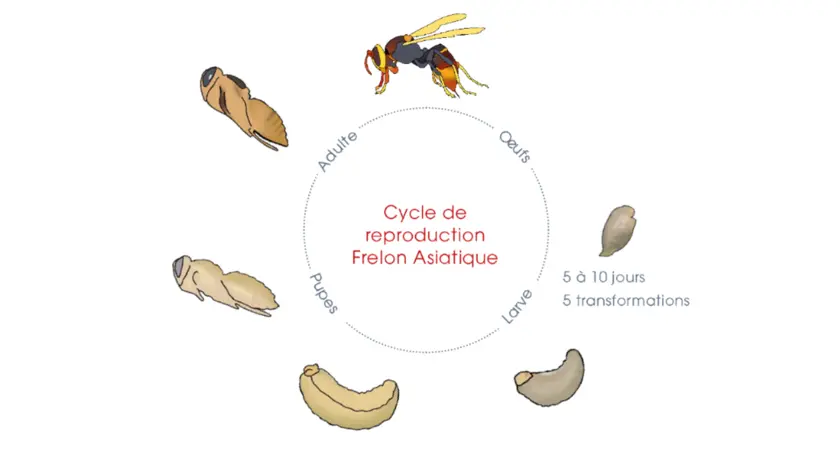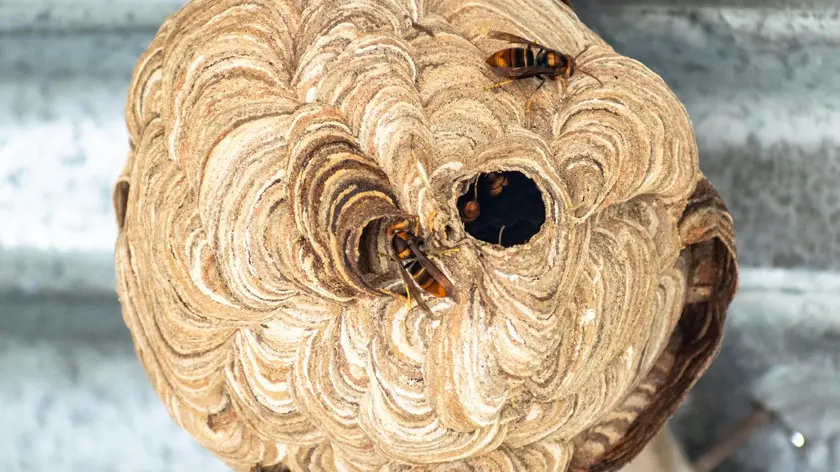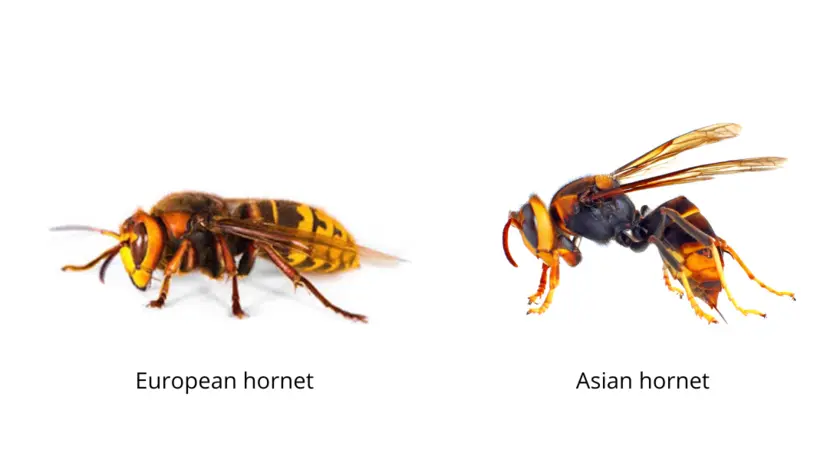Everything you need to know about the Asian hornet: size, lifespan, nest, sting, trap...
How to recognize Asian hornets?
As its name suggests, the Asian hornet is native to Asia and began its invasion of Europe in 2004. Its introduction into Europe proved to be accidental. It can be explained by the transport of pottery and plants, which allowed the founding queen to build an Asian hornet's nest and establish a colony.
The characteristics of the Asian hornet:
-
Height: Between 1.7cm and 3.5cm (up to 3.5cm for the queen, and on average 2cm for other castes).
-
Color: black with an orange stripe and yellow legs.
-
Lifespan: one year for the queen.
It has a cycle of complete metamorphosis (egg, larva, pupa, and adult).
Reproductive cycle of an Asian hornet
This pest lives in colonies. Its nest can be spherical, measuring 60 cm in diameter, or ovular reaching up to 1 meter high. It builds its nest with cellulose fibers that it transforms into pulp, making it strong enough to protect it from rain or wind.

The Asian hornets' nest
This pest lives in colonies. Its nest can be spherical, measuring 60 cm in diameter, or ovular reaching up to 1 meter high. It builds its nest with cellulose fibers that it transforms into pulp, making it strong enough to protect it from rain or wind.

What to do or what trap to use in case of an Asian hornet infestation?
If you notice the presence of Asian hornets or a nest in your environment (home, workplace...), it is essential to call on qualified professionals. Do not try to address the problem yourself as the Asian hornets are dangerous and it could lead to fatal stings.
Thanks to the experience and know-how of our Elis Pest Control technicians, we can deal with the situation safely, quickly, and efficiently, minimizing the dangers to you and people around you.
All our specialized technicians have Certibiocide in accordance with the regulations.
Ask for a quoteThe Asian hornet sting: a danger for humans
The venom of the Asian hornet contains chemical compounds distinct from those found in bees and wasps. Repeated stings by an Asian hornet in sensitive areas, or an allergy to the venom, can trigger serious reactions, even requiring hospitalization for some people.
Unlike its cousins, this pest can sting successively without losing its stinger when it feels threatened. With each sting, the Asian Hornet injects a little more venom into the bloodstream.
The differences between the European hornet and the Asian hornet
The Asian hornet is smaller than the European hornet. The Asian hornet measures on average 2 cm compared to 2.5 cm for the European hornet.
Both species are territorial and can become aggressive if they feel threatened. However, the Asian hornet is considered more dangerous than the European hornet, especially when defending its nest.
The Asian hornet is also more agile in flight. It can hover for long periods when hunting bees, which it loves to consume, to keep an eye on hives and nests.

An impact on the ecosystem
The territory of the Vespa Velutina has been expanding by an average of 60 km every year since 2004. They quickly became a danger due to their destructive eating habits.
Among the main dangers caused by the presence of Asian hornets, two major problems stand out:
-
Their attacks on orchards, endangering pollination, and harvests.
-
Their predation on bee populations. Indeed, bees make up 30% of the diet of an Asian hornet. Asian hornet predation has a considerable impact on the health of bees. By hunting bees, the Asian hornet cause significant stress, which restricts their nectar and pollen harvests, and reduces their reserves for the winter.
If you need information or a quote for your project, our teams are here to help. Contact us!
*Required fields
Account details








